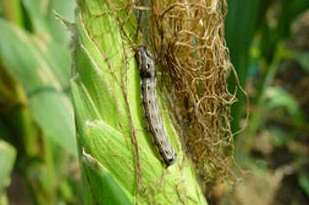The ground tiger is a winter sweet corn seedling pest, mainly terrestrial tiger, small tiger, and yellow tiger. Such pests damage the lobular or young leaves of sweet corn, and even bite the young stems at the base of the seedlings, resulting in lack of seedlings and ridges, which seriously affect the whole seedlings. Control measures: First, manual capture. In the early morning, around the sweet corn seedlings or along the damaged plants remaining in the hole, the soil is opened to catch the larvae. The second is poison bait trapping. 50 grams of 90% trichlorfon crystals per mu, dissolved in warm water into 250 ml of liquid medicine, mixed with sauteed peanut bran, and sprinkled around the corn in the evening.
The locusts that harm sweet corn in Taiwan and Datun are mainly Datun and Taiwanese crickets. The larvae feed on the heart, affecting photosynthesis, hindering growth, feeding on stems, and easily folding winds; feeding on male and female ears, reducing the rate of pollination, and directly feeding on the grains. Control measures: Apply at the big bell mouth. The medicinal agent can be selected from 3% Miller granules (1 kg per mu) or 98% Bataan WP (50 g per mu) or 90% trichlorfon crystals (150 g per mu, diluted with warm water) Sand dessert leaves are spread.

Corn borer occurs mainly during the tasseling stage of winter sweet corn, mainly affecting male flowers and affecting pollination. The locusts are small and breed fast, so they cannot be paralyzed. Control measures: spray with imidacloprid 2500 times solution or 1500 times solution.
Large spot disease and small spot disease are two diseases commonly occurring in winter sweet corn. When the occurrence is serious, the leaves can be killed, resulting in a reduction in production. Mainly harmful to the leaves, can also infect leaf tips and stalks. The two diseases are prone to prevalence at the booting and heading stage, low-lying land, too densely shaded, continuous cropping, and often severely affected. Control measures: remove the yellow leaves and diseased leaves in the lower part of the plant, and reduce the source of the re-infested bacteria to facilitate ventilation and light transmission. Spray the bactericide, the agent can be selected with 25% Bupper emulsifiable concentrate 2500 times solution or 50% carbendazim emulsifiable concentrate 500 times solution or 65% daikon zinc WP 1000 times solution.
Sheath blight is a more serious disease of winter sweet corn. Initially on the ground, 1-2 leaf tips occurred, mainly in the milky maturity of the leaves, ears, and grains. Soil stickiness, partial application of nitrogen fertilizer, low-lying terrain and plant closure, no ventilation, and poorly transmitted plots are beneficial to the disease. Control measures: First, improve cultivation management techniques. Pay attention to the drainage of the ditch and apply the decomposed organic fertilizer. The application of nitrogen fertilizer should be sooner rather than later, and should be less or less. Appropriate application of potassium fertilizer should be carried out to improve the disease resistance of plants. The second is chemical control. It can be used with 25% chlorhexidine emulsifiable concentrate 3000 times solution or 70% thiophanate-methyl WP 600 times solution or 40% ketonic suspension 500 times solution.
Physical Therapy Equipment,Therapy Medical Device,Physio Therapy Equipments,Shock Wave Therapy Devices
Puyang Degren Medical Equipment Co., Ltd. , https://www.degrenyuwei.com